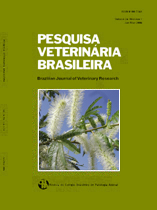 |
|
|
|
Year 2010 - Volume 30, Number 10
|

|
Congenital defects in ruminants in southern Brazil, 30(10):816-826
|
ABSTRACT.- Marcolongo-Pereira C., Schild A.L., Soares M.P., Vargas Jr S.F. & Riet-Correa F. 2010. [Congenital defects in ruminants in southern Brazil.] Defeitos congênitos diagnosticados em ruminantes na Região Sul do Rio Grande do Sul. Pesquisa Veterinária Brasileira 30(10):816-826. Laboratório Regional de Diagnóstico, Faculdade de Veterinária, Universidade Federal de Pelotas, Campus Universitário s/n, Pelotas, RS 96010-900, Brazil. E-mail: alschild@terra.com.br
Congenital defects in cattle, sheep and buffalo were studied through a review of necropsy files of the Regional Diagnostic Laboratory of the Veterinary Faculty at the Federal University of Pelotas between 1978 and 2009. The occurrence of congenital defects in cattle, sheep and buffalo were 0.88%, 0.36%, and 7.54%, respectively, from all specimens received. Cattle congenital defects of undetermined etiology represented 45.83% of the congenital defects, known hereditary and probably hereditary diseases represented 6.25%, and 29.16%, respectively, and defects associated to environmental factors represented 16.66%. In cattle, of the 48 congenital defects observed 21 (43.75%) affected the skeletal system (chondrodysplasia, scoliosis, lateral deviation of the mandible, palatoschisis and unclassified defect), nine (18.75%) affected the central nervous system (hypoplasia of olfatory and frontal lobes, cerebellar cortical degeneration, spina bifida, congenital hypomielinogenesis, hereditary hypermetria, cerebellar hypoplasia, and pachygiria), nine (18.75%) the muscular system (arthrogryposis), three (6.25%) the cardiovascular system (patent ductus arteriosus and unclassified malformation), one (2.08%) the lymphatic system (hereditary lymphatic hypoplasia), one (2.08%) the alimentary system (atresia ani), and one (2.08%) the eye (congenital blindness). In five cases (10.41%) different systems were affected (diprosopus). Different hereditary diseases (hereditary hypermetry, arthrogryposis, and lymphatic hypoplasia) or diseases suspected of being hereditary (chondrodysplasia) were diagnosed in cattle. Also occurred, with less frequency, congenital defects associated with environmental factors (hypomyelinogenesis due to cooper deficiency) or probably environmental factors (cleft palate, cerebellar hypoplasia, and cerebellar cortical degeneration). In sheep all observed defects were sporadic and affected various systems (anomalous twins and aprosopia). In buffalo all congenital defects were hereditary (arthrogryposis, myotonia and mechano-bullous genodermatoses) or suspected of being hereditary (albinism, megaesophagus and hydranencephaly/cerebellar hypoplasia). It is concluded that sporadic congenital defects are not important in the three species studied. Despite the low frequency congenital defects associated with environmental factors could be important in some regions or farms. Hereditary or probably hereditary diseases are important, not only by the mortality rates, but also because the risk of dissemination of the genes in the different breeds. In water buffalo the high prevalence of hereditary diseases was a consequence of the high consanguinity of the Brazilian buffalo population. Control measures need to be taken to avoid the spread of recessive genes in cattle and buffalo. |
| |
|
|
| |
|
 |